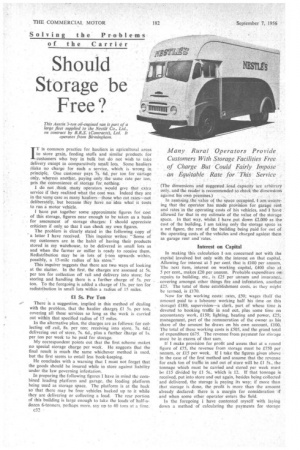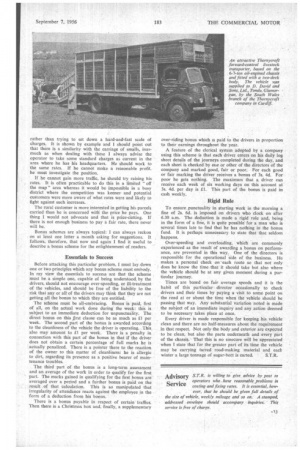Should Storage be Free?
Page 68

Page 71

If you've noticed an error in this article please click here to report it so we can fix it.
IT is common practice for hauliers in agricultural areas to store grain, feeding stuffs and similar products for customers who buy in bulk but do not wish to take delivery except in comparatively small lots. Some hauliers riiake no charge for such a service, which is wrong in principle. One customer pays 7s. 6d. per ton for cartage only, whereas another, paying only the same rate per ton, gets the convenience of storage for. nothing.
I do not think many operators would give that extra service if they realised what the cost was. Indeed they are in the same case as many hauliers—those who cut rates—not deliberately, but because they have no idea what it 'costs to run a motor vehicle.
I have put together some approximate figures for cost of this storage, figures near enough to be taken as a basis for assessment of storage charges: I should appreciate criticism if only so that I can cheek my own figures.
. The problem is clearly stated in the following copy of a letter I have received. This inquirer writes: "Some of my customers are in the habit of having their products stored in my warehouse, to be delivered in small lots as and when the farmer or miller is ready to receive them. Redistribution may be in lots of #-ton upwards within, possibly, a 15-mile radius of his store."
This inquirer suggests that there are two ways of looking at the Matter. In the first, the charges are assessed at 5s. per ton for collection off rail and delivery into store; for storing and handling there is a further charge of 5s. per ton. To the foregoing is added a charge of 15s. per ton for redistribution in small lots within a radius of 15 miles.
El 5s. Per Ton .
,o. There is a suggestion, implied in this method of dealing
with the problem, that the haulier charges £1 5s. per ton, covering all these services so long as the work is carried out within that specified radius of 15 miles.
In the alternative plan, the charges are as follows: for collecting off -rail, 8s. per ton; receiving into store,. 7s, 6d.; delivering out of store, 7s. 6d., plus a further Charge or Is. per ton per week to be paid for storage.
My correspondent points out that the first scheme makes no special storage charge per week. He suggests that the final result is much the same whichever method is used, but the first seems to entail less book-keeping.
He concludes with a warning that I must not forget that the goods should be insured while in store against liability under the law governing infestation.
In preparing the following figures I have in mind the combined loading platform and garage, the loading platform being used as storage space. The platform is at the back so that there may be four vehicles backed up to it while they are delivering or collecting a load. The rear portion of this building is large enough to take the loads of half-adozen 6-tonners, perhaps more, say up to 40 tons at a time. (The dimensions and suggested load Capacity are arbitrary only, and the reader is recommended to .cheek the dimensions against his own premises.) In assessing the value of the space occupied, I am assuming that the operator has made provision for garage rent and rates in the operating costs of his vehicles, and I have allowed for that in my estimate of the value of the storage space. In that way, whilst I have.put down £2,000 as the cost of the building, I am taking only the storage space as a net figure, the rest of the building being paid for out of the operating costs of the vehicles and charged against them as garage rent and rates.
Interest on Capital In making this calculation I. am concerned not with the capital involved but only with the interest on that capital. Allowing for interest at 5 per cent, that is £100 per annum_ The next item, interest on working capital, £400 also at 5 per cent., makes £20 per annum. Probable expenditure on repairs to building. etc., is £25 per annum and insurance. . covering amongst other things fire and infestation, another £25. The total of these establishment costs, as they might be termed, is £170.
Now for the working costs: rates, £50; wages (half the amount paid to a labourer working half his time on this storage) £180; supervision—a clerk, part of whose time is devoted to booking traffic in and out, plus some time on accountancy work, £150; lighting, heating and power, £25; management, part of the remuneration of the owner as his share of the amount he draws on his own account, £100. The total of these working costs is £505, and the grand total of expenditure £675. The revenue from payment for storage must be in excess of that sum.
If I make provision for profit and assess that at a round figure of £75, the revenue from storage must be £750 per annum, or £15 per week. If I take the figures given above in the case of the first method and assume that the revenue for each ton of traffic in and out of store will be £1 5s., the tonnage which must be carried and stored per week must be £15 divided by £1 5s., which is 12. If that tonnage is received, put into store and out again, besides being collected and delivered, the storage is paying its way: if more than that storage is done, the profit is more than the amount already declared: there is a margin for consideration if and when some other operator enters the field.
In the foregoing I have contented myself with laying down a method of calculating the payments for storage rather than trying to set down a hard-and-fast scale of charges. It is shown by example and I should point out that there is a similarity with the carriage of smalls, inasmuch as when dealing with these I always advise the operator to take some standard charges as current in the area where he has his headquarters. He should work to the same rates. If he cannot make a reasonable profit.
• he must investigate the position.
If he cannot gain more traffic, he should try raising his rates. It is often practicable to do this in a limited "off the map" area whereas it would be impossible in a busy district where the competition was keener and potential customers were more aware of what rates were and likely to fight against such increases.
The rural customer is more interested in getting his parcels carried than he is concerned with' the price he pays. One thing I would not advocate and that is price-clitting. If there is not enough business to pay a fair rate, there never will be. • Bonus schemes are always topical: I can always reckon • on at least one letter a month asking for suggestions. It follows, therefore, that now and again I find it useful to describe a bonus scheme for the enlightenment of readers.
Essentials to Success
Before attacking this particular problem, I must lay.down one or two principles which any bonus scheme must embody. In my view the essentials to success are that the scheme must be a simple one, capable of being understood, by the drivers, should not encourage over-speeding, or ill-treatment of the vehicles, and should be free of the liability to the ,risk that any or alt of the drivers may think that they are not getting all the bonus to which they are entitled.
The scheme must be all-embracing. Bonus is paid, first of all, on the actual work done during the week: this is subject to an immediate deduction for unpunctuality. The direct bonus on this first clause can be as much as £1 per week. The second part of the bonus is awarded according to the cleanliness of the vehicle the driver is operating. This, also may amount to £1 per week. There is a penalty in connection with this part of the bonus in that if the driver does not obtain a certain percentage of full marks he is actually penalized. There is a pointer there to the reaction of the owner to this matter of cleanliness: he is allergic to dirt, regarding its presence as a positive bearer of maintenance troubles.
The third part of the bonus is a long-term assessment and an average of the wort in order to qualify for the first part. The marks gained in qualifying for the first bonus are averaged over a period and a further bonus is paid on the result of that calculation. This is so manipulated that irregularity of attendance reacts against the employee in the form of a deduction from his bonus.
There is a bonus payable in respect of certain' traffics. Then there is a Christmas box and, finally, a supplementary over-riding bonus which is paid to the drivers in proportion to their earnings throughout the year.
A feature of the clerical system adopted by a company using this scheme is that each driver enters on his daily log sheet details of the journeys completed during the day, and each sheet is checked by one or other of the directors of the company and marked good, fair or poor. For each good or fair marking the driver receives a bonus of 3s. 4d. For poor he gets nothing. The maximum that a driver can receive each week of six working days on this account at 3s. 4d. per day is £1. This part of the bonus is paid in cash weekly.
Rigid Rule To ensure punctuality in starting work in the morning a fine of 2s. 6d. is imposed on drivers who clock on after 6.30 a.m. The deduction is made a rigid rule and, being in the form of a fine, it is quite possiblefor a man who is several times late to find that he has nothing in the bonus fund. It is perhaps unnecessary to state that that seldom happens.
Over-speeding and overloading, which are commonly experienced as the result of awarding a bonus on performance, are prevented in this way. One of the directors is responsible for the operational side of the business. He makes a personal check on 'each route so that not only does he know the time that• it should take but also where the vehicle should be at any given moment during a particular journey.
Times are based on fair average speeds and it is the habit of this particular director occasionally to check drivers and their times by paying a visit to some point on the road at or about the time when the vehicle should be passing that way. Any substantial variation noted is made the subject of an immediate inquiry and any action deemed to be necessary takes place at once.
Every driver is made responsible for keeping his vehicle clean and there are no half-measures about the requirement in that respect, Not only the body and exterior are expected to be clean, but also the parts underneath and every part of the chassis. That this is no sinecure will be appreciated when I state that for the greater part of its time the vehicle may be carrying tarred road-making material • and each winter a large tonnage of sugar-beet is carted. S.T.R.








































































































